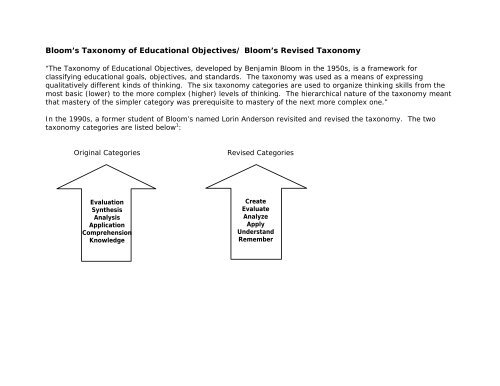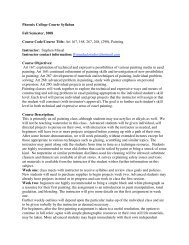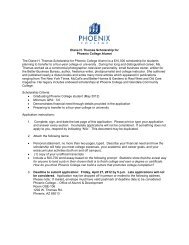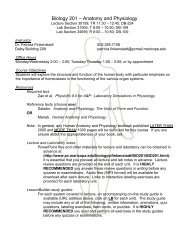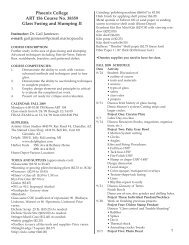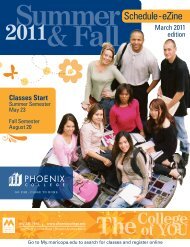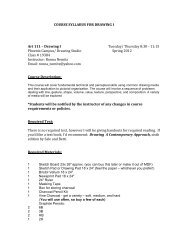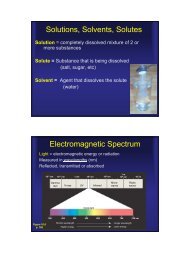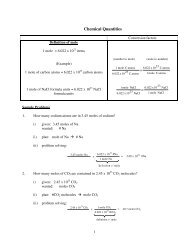Bloom's Taxonomy of Educational Objectives/ Bloom's Revised ...
Bloom's Taxonomy of Educational Objectives/ Bloom's Revised ...
Bloom's Taxonomy of Educational Objectives/ Bloom's Revised ...
You also want an ePaper? Increase the reach of your titles
YUMPU automatically turns print PDFs into web optimized ePapers that Google loves.
Bloom’s <strong>Taxonomy</strong> <strong>of</strong> <strong>Educational</strong> <strong>Objectives</strong>/ Bloom’s <strong>Revised</strong> <strong>Taxonomy</strong><br />
“The <strong>Taxonomy</strong> <strong>of</strong> <strong>Educational</strong> <strong>Objectives</strong>, developed by Benjamin Bloom in the 1950s, is a framework for<br />
classifying educational goals, objectives, and standards. The taxonomy was used as a means <strong>of</strong> expressing<br />
qualitatively different kinds <strong>of</strong> thinking. The six taxonomy categories are used to organize thinking skills from the<br />
most basic (lower) to the more complex (higher) levels <strong>of</strong> thinking. The hierarchical nature <strong>of</strong> the taxonomy meant<br />
that mastery <strong>of</strong> the simpler category was prerequisite to mastery <strong>of</strong> the next more complex one.”<br />
In the 1990s, a former student <strong>of</strong> Bloom’s named Lorin Anderson revisited and revised the taxonomy. The two<br />
taxonomy categories are listed below 1 :<br />
Original Categories<br />
<strong>Revised</strong> Categories<br />
Evaluation<br />
Synthesis<br />
Analysis<br />
Application<br />
Comprehension<br />
Knowledge<br />
Create<br />
Evaluate<br />
Analyze<br />
Apply<br />
Understand<br />
Remember
Knowledge Processes<br />
• Factual Knowledge – The basic elements that students must know to be acquainted with a discipline or solve<br />
problems in it.<br />
• Conceptual Knowledge – The interrelationships among the basic elements within a larger structure that<br />
enable them to function together.<br />
• Procedural Knowledge – How to do something; methods <strong>of</strong> inquiry, and criteria for using skills, algorithms,<br />
techniques, and methods.<br />
• Meta-cognitive Knowledge – Knowledge <strong>of</strong> cognition in general as well as awareness and knowledge <strong>of</strong> one’s<br />
own cognition<br />
Cognitive Processes<br />
• Remember – Retrieving relevant knowledge from long-term memory.<br />
o Recognizing, Recalling<br />
• Understand – Determining the meaning <strong>of</strong> instructional messages, including oral, written, and graphic<br />
communication.<br />
o Interpreting, Exemplifying, Classifying, Inferring, Comparing, Explaining<br />
• Apply – Carrying out or using a procedure in a given situation.<br />
o Executing, Implementing<br />
• Analyze – Breaking material into its constituent parts and detecting how the parts relate to one another and<br />
to an overall structure or purpose.<br />
o Differentiating, Organizing, Attributing<br />
• Evaluate – Making judgments based on criteria and standards.<br />
o Checking, Critiquing<br />
• Create – Putting elements together to form a novel, coherent whole or make an original product.<br />
o Generating, Planning, Producing
Verbs/Verb Phrases<br />
The verb or verb phrase <strong>of</strong> a learning objective describes the students’ expected performance (what they are being<br />
asked to do with the discipline’s content). Learning objectives should include verbs at higher levels <strong>of</strong> the taxonomy<br />
to elicit student performance that is more complex than mere recall <strong>of</strong> information. The following table lists<br />
examples <strong>of</strong> verbs that can be used at the six levels.<br />
Remember<br />
Arrange, Count, Define, Describe, Draw, Duplicate,<br />
Identify, Label, List, Match, Name, Order, Point, Quote,<br />
Read, Recall, Recite, Recognize, Record, Repeat,<br />
Reproduce, Select, State, Write<br />
Apply<br />
Add, Apply, Calculate, Change, Choose, Classify,<br />
Complete, Compute, Demonstrate, Determine,<br />
Develop, Discover, Divide, Dramatize, Employ,<br />
Examine, Formulate, Graph, Illustrate, Interpret,<br />
Manipulate, Modify, Multiply, Operate, Organize,<br />
Perform, Practice, Predict, Prepare, Produce, Relate,<br />
Schedule, Shop, Show, Sketch, Solve, Subtract,<br />
Translate, Use<br />
Understand<br />
Associate, Classify, Compare, Compute, Contrast,<br />
Convert, Describe, Differentiate, Discuss, Distinguish,<br />
Explain, Express, Extend, Generalize, Give Examples,<br />
Identify, Indicate, Locate, Listing, Matching, Paraphrase,<br />
Predict, Recognize, Report, Restate, Review, Rewrite,<br />
Select, Sort, Summarize, Tell, Translate<br />
Analyze<br />
Analyze, Appraise, Arrange, Breakdown, Calculate,<br />
Combine, Compare, Contrast, Criticize, Design, Detect,<br />
Determine, Develop, Diagram, Differentiate,<br />
Discriminate, Distinguish, Estimate, Examine,<br />
Experiment, Extrapolate, Formulate, Identify, Illustrate,<br />
Infer, Inspect, Inventory, Outline, Point Out, Question,<br />
Relate, Select, Separate, Subdivide, Test, Utilize
Evaluate<br />
Appraise, Argue, Assess, Attack, Choose, Compare,<br />
Conclude, Contrast, Criticize, Critique, Defend,<br />
Determine, Estimate, Evaluate, Grade, Interpret,<br />
Judge, Justify, Measure, Predict, Rank, Rate, Revise,<br />
Score, Select, Support, Test, Value, Weigh<br />
Create<br />
Arrange, Assemble, Categorize, Collect, Combine,<br />
Compile, Compose, Construct, Create, Debate, Derive,<br />
Design, Devise, Explain, Formulate, Generate, Group,<br />
Integrate, Manage, Modify, Order, Organize, Plan,<br />
Prepare, Prescribe, Produce, Propose, Rearrange,<br />
Reconstruct, Relate, Reorganize, Revise, Rewrite,<br />
Specify, Summarize, Synthesize, Tell, Transform<br />
Question Stems<br />
“Questioning should be used purposefully to achieve well-defines goals. Since <strong>Bloom's</strong> <strong>Taxonomy</strong> is a classification<br />
<strong>of</strong> thinking organized by level <strong>of</strong> complexity, it gives instructors and students an opportunity to learn and practice a<br />
range <strong>of</strong> thinking and provides a simple structure for many different kinds <strong>of</strong> questions and thinking. The taxonomy<br />
involves all categories <strong>of</strong> questions, and typically an instructor will vary the level <strong>of</strong> questions within a single<br />
lesson 2 .”<br />
Questions that fall in the lower level <strong>of</strong> the taxonomy (at the remembering, understanding and lower level<br />
application levels) are appropriate for 3 :<br />
• Evaluating students’ preparation and comprehension<br />
• Diagnosing students’ strengths and weaknesses<br />
• Reviewing and/or summarizing content<br />
Questions that fall in the higher level <strong>of</strong> the taxonomy (those requiring complex application, analysis, evaluation or<br />
creation skills) are appropriate for 4 :<br />
• Encouraging students to think more deeply and critically<br />
• Problem solving<br />
• Encouraging discussions<br />
• Stimulating students to seek information on their own
Sample Questions by Level 5<br />
Remember<br />
• What happened after...?<br />
• How many...?<br />
• What is...?<br />
• Who was it that...?<br />
• Can you name ...?<br />
• Find the meaning <strong>of</strong>…<br />
• Describe what happened after…<br />
• Who spoke to...?<br />
• Which is true or false...?<br />
Apply<br />
• Do you know <strong>of</strong> another instance where…?<br />
• Can you group by characteristics such as…?<br />
• Which factors would you change if…?<br />
• What questions would you ask <strong>of</strong>…?<br />
• From the information given, can you<br />
develop a set <strong>of</strong> instructions about…?<br />
Evaluate<br />
• Is there a better solution to...?<br />
• Judge the value <strong>of</strong>... What do you think<br />
about...?<br />
Understand<br />
• Can you write in your own words?<br />
• How would you explain…?<br />
• Can you write a brief outline...?<br />
• What do you think could have happened next...?<br />
• Who do you think...?<br />
• What was the main idea...?<br />
• Can you clarify…?<br />
• Can you illustrate…?<br />
Analyze<br />
• Which events could not have happened?<br />
• If. ..happened, what might the ending have been?<br />
• How is...similar to...?<br />
• What do you see as other possible outcomes?<br />
• Why did...changes occur?<br />
• Can you explain what must have happened when...?<br />
• What are some or the problems <strong>of</strong>...?<br />
• Can you distinguish between...?<br />
• What were some <strong>of</strong> the motives behind..?<br />
• What was the turning point?<br />
• What was the problem with...?<br />
Create<br />
• Can you design a...to...?<br />
• Can you see a possible solution to...?<br />
• If you had access to all resources, how would you
• Can you defend your position about...?<br />
• Do you think...is a good or bad thing?<br />
• How would you have handled...?<br />
• What changes to.. would you recommend?<br />
• Do you believe...? How would you feel if. ..?<br />
• How effective are. ..?<br />
• What are the consequences..?<br />
• What influence will....have on our lives?<br />
• What are the pros and cons <strong>of</strong>....?<br />
• Why is ....<strong>of</strong> value?<br />
• What are the alternatives?<br />
• Who will gain & who will lose?<br />
deal with...?<br />
• Why don't you devise your own way to...?<br />
• What would happen if ...?<br />
• How many ways can you...?<br />
• Can you create new and unusual uses for...?<br />
• Can you develop a proposal which would...?
L<br />
O<br />
W<br />
E<br />
R<br />
To<br />
U<br />
P<br />
P<br />
E<br />
R<br />
L<br />
E<br />
V<br />
E<br />
L<br />
Of<br />
M<br />
A<br />
S<br />
T<br />
E<br />
R<br />
Y<br />
Bloom’s <strong>Revised</strong> <strong>Taxonomy</strong> for Creating Learning <strong>Objectives</strong><br />
Category Verbs Instructional Strategies/Products<br />
Remember<br />
Recognizing, Recalling<br />
Understand<br />
Interpreting,<br />
Exemplifying,<br />
Classifying, Inferring,<br />
Comparing, Explaining<br />
Apply<br />
Executing,<br />
Implementing<br />
Analyze<br />
Differentiating,<br />
Organizing, Attributing<br />
Evaluate<br />
Checking, Critiquing<br />
Create<br />
Generating, Planning,<br />
Producing<br />
Arrange, Count, Define, Describe, Draw, Duplicate, Identify,<br />
Label, List, Match, Name, Order, Point, Quote, Read, Recall,<br />
Recite, Recognize, Record, Repeat, Reproduce, Select, State,<br />
Write<br />
Associate, Classify, Compare, Compute, Contrast, Convert,<br />
Describe, Differentiate, Discuss, Distinguish, Explain, Express,<br />
Extend, Generalize, Give Examples, Identify, Indicate, Locate,<br />
Listing, Matching, Paraphrase, Predict, Recognize, Report,<br />
Restate, Review, Rewrite, Select, Sort, Summarize, Tell,<br />
Translate<br />
Add, Apply, Calculate, Change, Choose, Classify, Complete,<br />
Compute, Demonstrate, Determine, Develop, Discover, Divide,<br />
Dramatize, Employ, Examine, Formulate, Graph, Illustrate,<br />
Interpret, Manipulate, Modify, Multiply, Operate, Organize,<br />
Perform, Practice, Predict, Prepare, Produce, Relate, Schedule,<br />
Shop, Show, Sketch, Solve, Subtract, Translate, Use<br />
Analyze, Appraise, Arrange, Breakdown, Calculate, Combine,<br />
Compare, Contrast, Criticize, Design, Detect, Determine,<br />
Develop, Diagram, Differentiate, Discriminate, Distinguish,<br />
Estimate, Examine, Experiment, Extrapolate, Formulate,<br />
Identify, Illustrate, Infer, Inspect, Inventory, Outline, Point<br />
Out, Question, Relate, Select, Separate, Subdivide, Test, Utilize<br />
Appraise, Argue, Assess, Attack, Choose, Compare, Conclude,<br />
Contrast, Criticize, Critique, Defend, Determine, Estimate,<br />
Evaluate, Grade, Interpret, Judge, Justify, Measure, Predict,<br />
Rank, Rate, Revise, Score, Select, Support, Test, Value, Weigh<br />
Arrange, Assemble, Categorize, Collect, Combine, Compile,<br />
Compose, Construct, Create, Debate, Derive, Design, Devise,<br />
Explain, Formulate, Generate, Group, Integrate, Manage,<br />
Modify, Order, Organize, Plan, Prepare, Prescribe, Produce,<br />
Propose, Rearrange, Reconstruct, Relate, Reorganize, Revise,<br />
Rewrite, Specify, Summarize, Synthesize, Tell, Transform<br />
Analogies, Audio, Charts, Examples,<br />
Illustrations, Lecture, Timelines, Video, Visuals<br />
Quiz, Definition, Fact, Worksheet, Test, Label,<br />
List, Workbook, Reproduction, Vocabulary<br />
Discussion, Learner Presentations, Questions<br />
and Answers, Reports, Summaries, Recitation,<br />
Summary<br />
Collection, Explanation, Show and tell,<br />
Example, Quiz, List, Label, Outline<br />
Demonstrations, Exercises, Microteach,<br />
Practice, Projects, Role Play, Simulations,<br />
Sketches<br />
Photograph, Illustration, Sculpture,<br />
Presentation, Interview, Performance, Diary,<br />
Journal<br />
Case Studies, Critical Incidents, Discussion,<br />
Problems<br />
Graph, Spreadsheet, Checklist, Chart, Outline,<br />
Survey, Database, Mobile, Abstract, Report<br />
Appraisals, Case Studies, Critiques, Exercises,<br />
Projects, Simulations<br />
Debate, Panel, Report, Evaluation,<br />
Investigation, Verdict, Conclusion, Persuasive<br />
speech<br />
Case Studies, Constructs, Creative Exercises,<br />
Develop Plans, Problems, Projects, Simulations<br />
Film, Story, Plan, New game, Newspaper,<br />
Media product, Advertisement, Painting, Song
Resources for More Information 6 :<br />
<strong>Bloom's</strong> (1956) <strong>Revised</strong> <strong>Taxonomy</strong><br />
• An excellent introduction and explanation <strong>of</strong> the revised <strong>Taxonomy</strong> by<br />
Michael Pole on the oz-TeacherNet site written for the QSITE Higher order<br />
Thinking Skills Online Course 2000. Pohl explains the terms and provides a<br />
comprehensive overview <strong>of</strong> the sub-categories, along with some suggested<br />
question starters that aim to evoke thinking specific to each level <strong>of</strong> the<br />
taxonomy. Suggested potential activities and student products are also<br />
listed.<br />
http://rite.ed.qut.edu.au/oz-teachernet/training/bloom.html<br />
Bloom’s <strong>Revised</strong> <strong>Taxonomy</strong><br />
• Another useful site for teachers with useful explanations and examples <strong>of</strong><br />
questions from the College <strong>of</strong> Education at San Diego State University.<br />
http://coe.sdsu.edu/eet/articles/bloomrev/index.htm<br />
<strong>Taxonomy</strong> <strong>of</strong> Technology Integration<br />
• This site compiled by the Berglund Center for Internet Studies at Pacific<br />
University, makes a valiant effort towards linking ICT (information and<br />
communication technologies) to learning via <strong>Bloom's</strong> <strong>Revised</strong> <strong>Taxonomy</strong> <strong>of</strong><br />
<strong>Educational</strong> <strong>Objectives</strong> (Anderson, et. al., 2001). The taxonomy presented on<br />
this site is designed to represent the varying cognitive processes that can be<br />
facilitated by the integration <strong>of</strong> ICT into the teaching and learning process.<br />
http://education.ed.pacificu.edu/aacu/workshop/reconcept2B.html<br />
Critical and Creative Thinking - <strong>Bloom's</strong> <strong>Taxonomy</strong><br />
• Part <strong>of</strong> Eduscape.com, this site includes a definitive overview <strong>of</strong> critical and<br />
creative thinking as well as how Bloom’s domains <strong>of</strong> learning can be reflected<br />
in technology-rich projects. Many other links to Internet resources to<br />
support Bloom’s <strong>Taxonomy</strong>, as well as research and papers on Thinking<br />
Skills. Well worth a look.<br />
http://eduscapes.com/tap/topic69.htm
1 Denise Margaret Tarlintonv. Available at<br />
http://www.kurwongbss.qld.edu.au/thinking/Bloom/bloomspres.ppt#256,1,Slide 1<br />
2 Denise Margaret Tarlintonv. Available at<br />
http://www.kurwongbss.qld.edu.au/thinking/Bloom/bloomspres.ppt#256,1,Slide 1<br />
3 Available: http://www.oir.uiuc.edu/Did/docs/QUESTION/quest1.htm<br />
4 Available: http://www.oir.uiuc.edu/Did/docs/QUESTION/quest1.htm<br />
5 Pohl (2000). Learning to Think, Thinking to Learn, pp. 7-8; 12-14<br />
6 Denise Margaret Tarlintonv. Available at<br />
http://www.kurwongbss.qld.edu.au/thinking/Bloom/bloomspres.ppt#256,1,Slide 1


